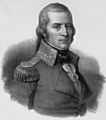Helvetic Republic facts for kids
In Swiss history, the Helvetic Republic (1798–1803) represented an early attempt to impose a central authority over Switzerland, which until then had consisted of self-governing cantons united by a loose military alliance (and ruling over subject territories such as Vaud).
The French invaded Switzerland and turned it into an ally known as the "Helvetic Republic". The interference with localism and traditional liberties was deeply resented, although some modernizing reforms took place. Resistance was strongest in the more traditional Catholic bastions, with armed uprisings breaking out in spring 1798 in the central part of Switzerland. The French Army suppressed the uprisings but support for revolutionary ideals steadily declined, as the Swiss resented their loss of local democracy, the new taxes, the centralization and the hostility to religion. Nonetheless, there were long-term impacts.
The Republic being named Helvetic after the Helvetii, the Gaulish inhabitants of the Swiss Plateau in antiquity, was not an innovation; rather, the Swiss Confederacy had occasionally been dubbed Republica Helvetiorum in humanist Latin since the 17th century, and Helvetia, the Swiss national allegory, made her first appearance in 1672.
Images for kids
-
William Tell fights the revolution (1798), by Dunker, praises the struggle of the Old Confederation against the Helvetic revolution supported by French invasion. It depicts the Swiss folk hero William Tell, carrying a shield with the Rütlischwur, and his son fighting the revolution, represented as a chimera wearing a phrygian cap
See also
 In Spanish: República Helvética para niños
In Spanish: República Helvética para niños







